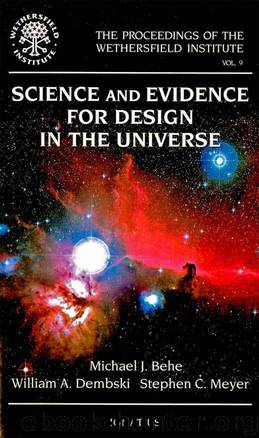Science and Evidence for Design in the Universe by Behe Michael & Dembski William & Meyer Stephen

Author:Behe, Michael & Dembski, William & Meyer, Stephen [Behe, Michael]
Language: eng
Format: mobi
Tags: Spiritual & Religion
ISBN: 9780898708097
Published: 2016-06-29T16:00:00+00:00
Part 1: The General Failure
of Demarcation Arguments
To show that design “can never be considered a scientific pursuit,”14 biologists and others have asserted that design does not meet certain objective criteria of scientific method or practice. In short, biologists have employed so-called demarcation arguments to separate a scientific approach to origins (descent) from an allegedly nonscientific approach (design). While an examination of the particular criteria employed in such arguments will not concern us in the first part of this essay, the general practice of demarcation will.
From the standpoint of the philosophy of science, the use of demarcation arguments is generally problematic. Historically, attempts to find methodological “invariants” that provide a set of necessary and sufficient conditions for distinguishing true science from pseudoscience have failed.15 Moreover, most current demarcation arguments presuppose an understanding of how science operates that reflects the influence of a philosophy of science known as logical positivism. Yet since the 1950s philosophers of science have decisively rejected positivism for a number of very good reasons (see below). As a result, the enterprise of demarcation has generally fallen into disrepute among philosophers of science.
In his essay “The Demise of the Demarcation Problem”, philosopher of science Larry Laudan gives a brief but thorough sketch of the different grounds that have been advanced during the history of science for distinguishing science from non-science.16 He notes that the first such grounds concerned the degree of certainty associated with scientific knowledge. Science, it was thought, could be distinguished from nonscience because science produced certainty whereas other types of inquiry such as philosophy produced opinion. Yet this approach to demarcation ran into difficulties as scientists and philosophers gradually realized the fallible nature of scientific disciplines and theories. Unlike mathematicians, scientists rarely provide strict logical demonstrations (deductive proofs) to justify their theories. Instead, scientific arguments often utilize inductive inference and predictive testing, neither of which produces certainty. As Owen Gingerich has argued, much of the reason for Galileo’s conflict with the Vatican stemmed from Galileo’s inability to meet scholastic standards of deductive certainty—a standard that he regarded as neither relevant to nor attainable by scientific reasoning.17 Similar episodes subsequently made it clear that science does not necessarily possess a superior epistemic status; scientific knowledge, like other knowledge, is subject to uncertainty.
By the nineteenth century, attempts to distinguish science from nonscience had changed. No longer did demarcationists attempt to characterize science on the basis of the superior epistemic status of scientific theories; rather, they attempted to do so on the basis of the superior methods science employed to produce theories. Thus science came to be defined by reference to its method, not its content. Demarcation criteria became methodological rather than epistemological.18
Nevertheless, this approach also encountered difficulties, not the least of which was a widespread disagreement about what the method of science really is. If scientists and philosophers cannot agree about what the scientific method is, how can they disqualify disciplines that fail to use it? Moreover, as the discussion of the historical sciences in part 3 of this essay will make clear, there may well be more than one scientific method.
Download
This site does not store any files on its server. We only index and link to content provided by other sites. Please contact the content providers to delete copyright contents if any and email us, we'll remove relevant links or contents immediately.
Signature in the Cell: DNA and the Evidence for Intelligent Design by Stephen C. Meyer(3054)
Real Sex by Lauren F. Winner(2949)
The Secret Power of Speaking God's Word by Joyce Meyer(2920)
The Holy Spirit by Billy Graham(2880)
The Gnostic Gospels by Pagels Elaine(2459)
Jesus by Paul Johnson(2294)
Devil, The by Almond Philip C(2266)
23:27 by H. L. Roberts(2186)
The Nativity by Geza Vermes(2165)
Chosen by God by R. C. Sproul(2113)
All Things New by John Eldredge(2090)
Angels of God: The Bible, the Church and the Heavenly Hosts by Mike Aquilina(1916)
The Return of the Gods by Erich von Daniken(1885)
Angels by Billy Graham(1876)
Knowing God by J.I. Packer(1793)
Jesus of Nazareth by Joseph Ratzinger(1754)
Evidence of the Afterlife by Jeffrey Long(1734)
The Gnostic Gospel of St. Thomas by Tau Malachi(1726)
How To Be Born Again by Billy Graham(1718)
